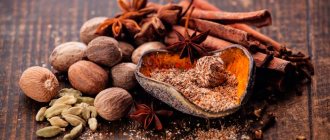April 23, 2015 Varieties and recipes
Oriental coffee is one of the oldest and most accessible methods of making coffee. This drink is prepared in a cezve, over an open small fire or on hot sand. Very often, spices are added to this oriental coffee to taste.
This is one of the most common and accessible coffee recipes today. In various sources, this drink is called differently: Turkish, Arabic, oriental coffee. Thanks to cooking in an open container, you can easily create the drink with as many additives as you like.
History of the origin of the drink
The Ethiopians were the first to prepare coffee beans. According to legend, even BC. The shepherd noticed that coffee beans had a stimulating effect on goats. He told about this in a monastery nearby. The monks tried the drink and felt the tonic effect, so they took it before evening prayers.
They experimented, roasted grains, and came up with cooking methods. At first, Ethiopians drank coffee only on special occasions, but gradually the frequency increased, and it became the hallmark of the country.
Over time, the drink was brought to Yemen by nomadic tribes and traders. The Arabs brewed coffee from the pulp of unroasted beans, so it turned out light. A method of preparation close to ours, oriental coffee was invented in the Middle East in the 12th century. Under the reign of Peter I, the drink firmly entered the culture of the nobility of that time and gradually spread to the common people of Russia.
Spices for an oriental recipe
There are no spices that are not suitable for Turkish (or oriental) coffee. Traditionally, cinnamon and vanilla were used, as well as cardamom in Arab countries.
But there are other varieties that can be added:
- ginger;
- nigella (Kalinji);
- carnation;
- star anise;
- black pepper or chili;
- coriander;
- saffron.
And others. There is no ban on coffee experiments. There is even a recipe with pink Indian salt. Why they drank coffee with salt in the East can be theoretically understood. Heat, lack of water, and coffee has a pronounced diuretic effect.
Salt helped retain water in the body. An analogue of salted coffee is salted Uzbek tea. Unlike simple salt, Indian salt contains almost the entire periodic table, therefore it is several times more useful. It is collected by hand near volcanoes.
Features of the Arabic drink
Coffee is prepared by hand, just like centuries ago. A real oriental drink cannot be prepared in a coffee machine. The fact is that the traditional recipe uses very fine grinding. It's essentially coffee dust.
Bitterness and rich taste are the hallmark of oriental coffee. Arabs always add spices to their coffee, such as cardamom. This makes the drink aromatic and spicy. Ideally, different types of grains are used. When fried, they have a light yellow color, which is achieved due to exposure to water vapor. A blend of Arabica and Robusta directly affects the richness.
Classic cooking method - subtleties and algorithm
The traditional recipe for Arabic coffee was brought to the present generation by the descendants of its connoisseurs from the countries of the East. Then the drink was brewed in dalls, monuments to which were erected in many countries around the world.
It was believed that every bride should be able to brew Arabic natural coffee. For example, in the Levant, the economic skills of girls of marriageable age were assessed based on the taste characteristics of the drink served.
The correct technological map for preparing real Arabic coffee is as follows:
- 10 g ground coffee beans;
- 105 ml of clean water;
- sugar to taste.
The preparation algorithm consists of several stages:
- Sugar is placed in a cezve and poured with water, bringing it to a boil.
- A mixture of ground coffee beans is placed in sugar syrup.
- While stirring the drink, wait for the formation of a coffee “cap”.
- Remove the coffee from the heat until it boils.
- Repeat the procedure several times.
- Remove the foam with a spoon.
The drink is poured into cups and foam is placed on top.
You might be interested in Gingerbread Coffee
The classic oriental coffee recipe guarantees a strong and invigorating drink without bitterness at home. To brew a drink that is milder in taste and less strong, add water to it at the boiling stage of the syrup and only then add coffee.
Spices and herbs are added to the drink according to taste, but more often the traditional version is used - cardamom.
Drinking culture
According to Eastern traditions, coffee is served according to seniority, from oldest to youngest. The host serves his guests at least 3 cups of drink. Asking for another cup is considered bad manners. You just need to accept gifts from the owner.
Only cups made of ceramics and porcelain are suitable for serving. Arabs believe that the taste of coffee will deteriorate if served in paper or plastic containers.
Drink coffee in small sips, washing down each sip of coffee with cold water, preferably with ice.
Rules for serving and consumption
Coffee is served in small cups, the grounds are not drained. To speed up the sediment, you can add a couple of drops of cold water to the cup. You should drink oriental coffee in small sips, washing it down with cold water, which makes it possible to fully appreciate the aroma and taste of the drink.
When serving, certain rules are followed: foam is poured into the cups first, after which the drink itself is poured. Sugar, spices and spoons are not served as all the necessary ingredients are added during cooking. The cups themselves can be thick-walled ceramic or special thin-walled glass, which maintain the temperature of the drink for a long time.
To serve, you can use special sets that include a Turk, a cup and a saucer, made in the same style. They are placed on a small tray, with a glass of water placed on the left. When serving, you can carefully collect the coffee foam with a spoon, pour the drink into cups, and then carefully place the collected foam on top.
Spices in oriental coffee
In Europe, coffee is also drunk with spices. Just look at the popularity of cinnamon. But if you take cardamom, its percentage in a cup is 10%. Eastern residents add much more cardamom, noting its beneficial properties for the body. For example, the spice cleanses the blood, improves the functioning of the heart and blood vessels, and also tones the body well.
Cardamom goes well with cinnamon, so you can safely put ground cinnamon in oriental coffee, or in the form of a stick. Cinnamon is also very beneficial for health. It can even lower your blood sugar levels. The spice is added to ready-made coffee.
Cloves and star anise will also not spoil the taste of oriental coffee. However, in this case, you should not combine them with cardamom; you need to replace it. A few grains of star anise allow you to feel the spicy taste.
Star anise is mixed with coffee in Turk. To reveal the full aroma, the finished drink can be covered with a lid for a few minutes, and only then start drinking.
Preparation
We've sorted out the technical side of the issue, now let's move on to the practical side. For the basic recipe you will need: - Turkish coffee - water - coffee - sugar For 10 ml of water, take about one gram of coffee, i.e. For one serving of 100 ml you will need about 10 grams. If you use a teaspoon, then the first time it is recommended to use scales in order to understand what volume it is and how much it weighs. The proportions may vary slightly depending on your taste and type of coffee.
Next, the coffee is poured into the cezve, sugar is added to it (1 teaspoon per 100 ml), and the whole thing is filled with water until the neck narrows. The resulting mixture must be stirred to break up any air lumps that have formed. If the volume of the cezve is less than 100 ml, then this is not necessary; the movement and pressure of the water inside, which will form as it heats up, will do this for you.
After the Turk is placed on the stove over medium heat, at the beginning you can even make it a little stronger to warm up the water, and then turn it down. Depending on the volume of the cezve, the coffee is prepared for 2.5-4 minutes, until it begins to boil and the coffee cap rises. As soon as this happens, the drink is ready, you need to remove the Turk from the heat so that it does not run away, there is no need to digest it, otherwise it will simply start to burn. The longer the cezve remains on the fire, the more bitterness the coffee releases. The finished coffee is immediately poured into cups. Whether to stir it or not is a controversial issue and again more likely relates to taste preferences.
YouTube tutorial videos and our coffee patrols.
Coffee on sand in a coffee shop: what to cook with
To prepare an oriental drink in a coffee shop you will need special equipment. We are talking about a heating platform into which fine-grained quartz sand is poured.
Such a device is connected to the power supply, after which it slowly warms up. As soon as the sand on the platform reaches a certain temperature, a cezve with coffee is placed in it.
The device in the form of a kind of brazier is not cheap, so you need to be especially careful when choosing it. And here you need to know a few subtleties:
- Equipment from good manufacturers is usually equipped with a Turk and sand. True, such a coffee set will cost a pretty penny. If the platform is sold without such components, you will have to select them yourself.
- Most coffee gourmets know that the best cezve is made of copper. Therefore, if you are choosing a Turk yourself, it is better to give preference to this particular metal.
- The dimensions of the fryer depend on the number of servings of the drink that need to be prepared at the same time. Coffee according to this recipe is drunk immediately after preparation, so it is advisable to take the volume of the Turkish coffee for one serving.
- The sand must be fine-grained, quartz. You can, of course, experiment with sea and river sand. But they do not hold heat as well as quartz.
Arabic coffee
This drink should be drunk in warm company and savored. He does not tolerate fuss, not during cooking, not during meals. Has a slightly bitter taste. The Egyptians equate it with a divine drink.
Components:
- ground coffee bean powder - 10 g;
- sugar - 10 g;
- water - 125 ml;
- cardamom - 0.7 g;
- vanillin - 0.7 g
Preparation:
- Pour all the ingredients into a cezve (a vessel with a long wooden handle). Fill the entire mass with water.
- Put it on slow gas. Wait until the foam appears. Remove from the oven and let stand for a while.
- Repeat the process two more times. The slower the drink is brewed, the better.
- Now all that remains is to skim off the foam into the cups with a spoon, and then pour the drink with the grounds and slowly enjoy the wonderful taste of aromatic coffee.
To prepare this divine drink, special Arabic coffee beans with the addition of cardamom are used. They should not be confused with Arabica coffee. Otherwise you will end up with a completely different drink.
Cardamom is an aphrodisiac. Among other things, this spice cleanses blood vessels, stimulates the normal functioning of the heart muscle, relieves excessive irritability, and gives energy.
When preparing the drink at home, you can make changes to the recipe. Add your favorite spices and make the coffee not so bitter or spicy. After all, no people have the same tastes and preferences. Therefore, recipes can and should be changed. Thanks to this, new ways of preparing incredibly tasty drinks from coffee beans are emerging.
Coffee came from the East
The version that coffee came from the East is confirmed by both botanists and historians. And although the birthplace of the coffee tree is Ethiopia, a country located in eastern Africa, Yemen should be considered the birthplace of the coffee drink. It was from here that the victorious march of coffee around the world began. From this Arab country, coffee came to Egypt, Turkey and Syria. Already in those days (14-15 centuries), the technology for preparing coffee drinks was practically no different from modern ones.
Coffee has a sacred meaning in the Islamic world. For a long time it was a substitute for wine, which is forbidden to the faithful. Coffee was used in religious ceremonies. The destruction of coffee trees was severely punished, including the death penalty. The reverent attitude towards the drink can be traced in today's coffee ceremonies in the countries of the East.
For example, Turkey still uses its own method of roasting grains. Beginning in the 14th century, roasted grains were ground together with spices and the addition of water. The coffee mixture was then roasted again. The resulting powder became known as Turkish coffee. This is the recipe for roasting Turkish coffee today.
In the homeland of coffee, in Yemen, the coffee drink was prepared from crushed, roasted coffee beans along with the shell. The coffee mixture was then brought to a boil twice, after which ginger root was added. The thick drink was poured into three sips: “The first is bitter like life, the second is sweet like love, the third is unknowable like death.”











